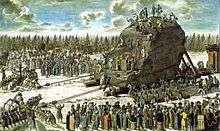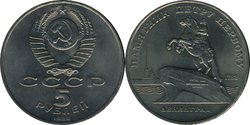Bronze Horseman
.jpg) | |
| Artist | Étienne Maurice Falconet |
|---|---|
| Year | 1768 - 1782 |
| Type | Equestrian Statue |
| Location | St Petersburg |
The Bronze Horseman (Russian: Медный всадник, literally "copper horseman") is an equestrian statue of Peter the Great in Saint Petersburg, Russia. Commissioned by Catherine the Great, it was created by the French sculptor Étienne Maurice Falconet. The name comes from an 1833 poem of the same name by Aleksander Pushkin, which is widely considered one of the most significant works of Russian literature. The statue is now one of the symbols of Saint Petersburg.
The statue's pedestal is the enormous Thunder Stone, the largest stone ever moved by humans.[1] The stone originally weighed about 1500 tonnes, and was carved down to 1250 during transportation to its current site.
Statue

The equestrian statue of Peter the Great is situated in the Senate Square (formerly the Decembrists Square), in Saint Petersburg. Catherine the Great, a German princess who married into the Romanov line, was anxious to connect herself to Peter the Great to gain legitimacy in the eyes of the people.[2] She ordered its construction, and had it inscribed with the phrase Petro Primo Catharina Secunda MDCCLXXXII in Latin and Петру перьвому Екатерина вторая, лѣта 1782 in Russian, both meaning 'Catherine the Second to Peter the First, 1782', an expression of her admiration for her predecessor and her view of her own place in the line of great Russian rulers. Having gained her position through a palace coup, Catherine had no legal claim to the throne and wanted to represent herself as Peter's rightful heir.
In correspondence with Catherine the Great, Denis Diderot suggested French sculptor Étienne Maurice Falconet, a friend of his, for the commission. The empress followed his advice and Falconet arrived in Russia in 1766.[3]
In 1775 the casting of the statue began, supervised by caster Emelyan Khailov. At one point during the casting, the mould broke, releasing molten bronze that started several fires. All the workers ran except Khailov, who risked his life to salvage the casting.[3] After being remelted and recast, the statue was later finished. It took 12 years, from 1770 to 1782, to create the Bronze Horseman, including pedestal, horse and rider.
The tsar's face is the work of the young Marie-Anne Collot, then only 18 years old. She had accompanied Falconet as an apprentice on his trip to Russia in 1766. A student of Falconet and Jean-Baptiste Lemoyne, Collot was called Mademoiselle Victoire (Miss Victory) by Diderot. She modelled Peter the Great's face on his death mask and numerous portraits she found in Saint Petersburg. The right hand of the statue was modelled from a Roman bronze hand, found in 1771 in Voorburg in the Netherlands at the site of the ancient Roman town Forum Hadriani.

On 7 August 1782, fourteen years after excavation of the pedestal began, the finished statue was unveiled in a ceremony with thousands in attendance. Conspicuously absent was Falconet, as a misunderstanding between him and the empress turned into a serious conflict. As a result, he was forced to leave Russia four years before the project was completed. Catherine largely forgot about him afterwards, and came to see the Bronze Horseman as her own oeuvre.[3]
The statue portrays Peter the Great sitting heroically on his horse, his outstretched arm pointing towards the River Neva in the west. The sculptor wished to capture the exact moment of his horse rearing at the edge of a dramatic cliff. His horse can be seen trampling a serpent, variously interpreted to represent treachery, evil, or the enemies of Peter and his reforms.[4] The statue itself is about 6 m (20 feet) tall, while the pedestal is another 7 m (25 feet) tall, for a total of approximately 13 m (45 feet).[5]
Thunder Stone

For the pedestal, an enormous rapakivi granite monolith boulder known as the Thunder Stone (Russian: Гром-Камень) was found at Lakhta, 6 km (3.7 mi) inland from the Gulf of Finland in 1768.[6] The Thunder Stone gained its name from a local legend that thunder split a piece off the stone. Falconet wanted to work on shaping the stone in its original location, but Catherine ordered it be moved before being cut.[7] As it was embedded to half its depth in the ground and the area was marshy terrain, the Russians had to develop new methods to dig up and transport the colossal stone. Marinos Carburis (Μαρίνος Χαρμπούρης), a Greek from the Island of Kefallonia and serving as lieutenant-colonel in the Russian Army, offered to undertake the project. Carburis had studied engineering in Vienna and is considered to be the first Greek to hold a diploma in engineering.[8]
Carburis directed workmen to wait for winter, when the ground was frozen, and then had them drag the large stone over the frozen ground to the sea for shipment and transport to the city. He developed a metallic sledge that slid over bronze spheres about 13.5 cm (6 inches) in diameter, over a track. The process worked in a way similar to the later invention of ball bearings. Making the feat even more impressive was that the labour was done entirely by humans; no animals or machines were used in bringing the stone from the original site to the Senate Square.[8] After Carburis devised the method, it took 400 men nine months to move the stone, during which time master stonecutters continuously shaped the enormous granite monolith.[3] Catherine periodically visited the effort to oversee their progress. The larger capstans was turned by 32 men, this just barely moving the rock. A further complication was the availability of only 100 m of track, which had to be constantly disassembled and relaid.[8] Nevertheless, the workers made over 150 m of progress a day while on level ground. Upon arrival at the sea an enormous barge was constructed exclusively for the Thunder Stone. The vessel had to be supported on either side by two full-size warships.[8] After a short voyage, the stone reached its destination in 1770, after nearly two years of work. A medal was issued to commemorate its arrival, with the legend "Close to Daring".[7]

According to the fall 1882 edition of La Nature, the stone's dimensions before being cut were 7 × 14 × 9 m. Based on the density of granite, its weight was determined to be around 1500 tonnes.[8] Falconet had some of this cut away shaping it into a base, so the finished pedestal weighed slightly less.
Siege of Leningrad

A 19th-century legend states that while the Bronze Horseman stands in the middle of Saint Petersburg, enemy forces will not be able to conquer the city. During the 900-day Siege of Leningrad by the invading Germans during the Second World War (Leningrad being the city's name from 1924–1991), the statue was covered with sandbags and a wooden shelter. Thus protected it survived 900 days of bombing and artillery virtually untouched.[4] True to the legend, Leningrad was never taken.
Poem

The Bronze Horseman is the title of a poem written by Aleksandr Pushkin in 1833, widely considered to be one of the most significant works of Russian literature. Due to the popularity of his work, the statue came to be called the "Bronze Horseman". A major theme of the poem is conflict between the needs of the state and the needs of ordinary citizens.
In the poem, Pushkin describes the fates of the poor man Evgenii and his beloved Parasha during a severe flood of the Neva. Evgenii curses the statue, furious at Peter the Great for founding a city in such an unsuitable location and indirectly causing the death of his beloved. Coming to life, the horseman chases Evgenii through the city. The poem closes with the discovery of the young man's corpse in a ruined hut floating at the edge of the river.
In 1903 the artist Alexandre Benois published an edition of the poem with his illustrations, creating what was considered a masterwork of Art Nouveau.
The poem has inspired works in other genres: Reinhold Glière choreographed a ballet based on it, and Nikolai Myaskovsky's 10th Symphony (1926–7) was inspired by the poem.
Gallery
 Statue of Peter the Great in the Winter
Statue of Peter the Great in the Winter
References
- ↑ Adam 1977, p. 42−45
- ↑ "St. Petersburg in Architecture: The Bronze Horseman". University of Michigan Taubman College of Architecture + Urban Planning. 2003. Archived from the original on 31 December 2006. Retrieved 22 April 2007.
- 1 2 3 4 "Bronze Horseman". Optima. 2007. Retrieved 23 April 2007.
- 1 2 "The Bronze Horseman". Saint-Petersburg.com. 2007. Retrieved 22 April 2007.
- ↑ "Saint Petersburg". TourArena. 2001. Retrieved 22 April 2007.
- ↑ "Lakhta". Saint Petersburg Encyclopaedia. Retrieved 22 April 2007.
- 1 2 "Thunder-Stone". Saint Petersburg Encyclopaedia. Retrieved 22 April 2007.
- 1 2 3 4 5 "Transport du piédestal de la statue de Pierre le Grand". La Nature magazine, second semester 1882. (in French). Retrieved 22 April 2007.
Notations
- (French) Histoire et statues des personnalités qui ont marqué Saint-Pétersbourg
- Adam, Jean-Pierre (1977), "À propos du trilithon de Baalbek: Le transport et la mise en oeuvre des mégalithes", Syria (in French), 54 (1/2): 31–63, doi:10.3406/syria.1977.6623
- (French) Les Français à Saint-Pétersbourg, extrait du livre de N.Smirnova, ci-dessous.
- (French) Transport du piédestal de la statue de Pierre le Grand, in La Nature, 1882.
- Ruprechtsberger, Erwin M. (1999), "Vom Steinbruch zum Jupitertempel von Heliopolis/Baalbek (Libanon)", Linzer Archäologische Forschungen (in German), 30: 7–56
Bibliography
- (French) Natalia Smirnova, Saint-Pétersbourg ou l'enlèvement d'Europe, éd. Olizane, Genève, 1996 ISBN 2-88086-191-8
- (French) Christiane Dellac, Marie-Anne Collot : Une sculptrice française à la cour de Catherine II, 1748–1821, L'Harmattan, (2005) ISBN 2-7475-8833-5.
Further reading
| Wikimedia Commons has media related to The Bronze Horseman (Saint Petersburg). |
- Alexander M. Schenker, The Bronze Horseman: Falconet's Monument to Peter the Great, Yale University Press, New Haven CT, 2003 ISBN 0-300-09712-3.
Coordinates: 59°56′11″N 30°18′08″E / 59.9364°N 30.3022°E